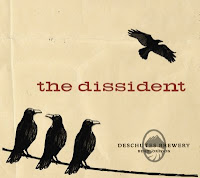You may imagine that the
tripels and
dubbels go back centuries--after all, it's one of the world's famous styles, and Trappist monks have been brewing for centuries.

Yet despite their stature, abbey ales of this type are relatively recent, having emerged from the examples brewed by the monks of
Westmalle Abbey after World War Two.
Abbey ales are the most well-known of all Belgian beers; it is therefore an education to sit down with a
Westmalle, the most influential brewery for the style, and the most imitated.
Westmalle's Tripel also happens to be the standard against which all other
tripels are judged--and appropriately so. It is an exceptional beer.
HistoryThe monastery was
founded in 1794, just northeast of Antwerp, in the Flemish-speaking Flanders region of western Belgium. The monks started brewing in the 1830s for their own use, and started selling beer to locals in the 1870s. This arrangement lasted until 1921, when
Westmalle began selling beer more widely. The famous line-up evolved over a period of years, becoming
recognizable in the 1950s. Since that time,
Westmalle has fiddled little with their styles, though the recipes do change to adjust for malt variations. Jackson reports that the brewers have used a variety of different hops--always whole flowers, never extract or pellets--and change them to their wish at the time.
Tasting NotesWhen you're dealing with a high-gravity beer, you're in a pick-your-poison situation. The perils include sweetness, heaviness of body, harsh alcohol, and over-hopping. When brewers make adjustments on one element, they may worsen another.
Westmalle's Tripel is a justifiable world standard because it manages to find a balance for all of these elements.
Let's start with the appearance. It is a familiar, cloudy golden. I marvel at the head on the beer, beautiful fluffy white and sustained, despite the alcohol. It's the liveliness of the beer that feeds the head, though it does not cascade with effervescence like some Belgians.

(After my final swallow, what remained in the bottom of my goblet was a skiff of head, coating the bottom of the glass like a dusting of snow.)
Westmalle is
hoppy, something that is not evident in the aroma (which is
caramelly and alcoholic and smells more like a
barleywine than a Belgian, oddly). It's not the first thing you notice--the sweet, rich, alcoholic notes muscle their way in first. But the hops are spicy and rescue the beer from becoming overly rich. The body is full and creamy, effervescent, but not heavy. I have had many
tripels that are either too thick or finish too sweetly. Not
Westmalle--the finish is long and dry. This is a big virtue of sugar--it allows the yeast to convert more sugars to alcohol, which produces a drier palate. It's fermented twice (before bottle-conditioning), and there's no information on the yeast strains. To my palate, there appear to be more than one variety, and I'd hazard a guess that there's even a little Brett in there (suspicions fostered by Orval--more on that in a later post).
If you drink the beer slowly enough, you'll find myriad flavors. Thick with
phenolics, the beer has the characteristic banana-clove-spice continuum. It's also
estery, a note cut off sharply--and
surprisingly--by the dry finish. Depending on how long the beer has been aging, you'll notice more or less hop bitterness. I prefer those moments when the hops come through, because it's a sneaky bitterness, one you welcome for its steadiness. You will find all or some of the following flavors, depending on the bottle and age--caramel, orange or lemon, mint, figs, and .... Well, you go buy a bottle and tell me.
At the start of my series, I said there were two excellent and one world-class Trappist ale. I include
Westmalle Tripel in the excellent category, and I can't quibble too much with those who declare it a world classic. It is the standard for the
tripel style, and it is certainly one of the best examples brewed.
StatsOriginal Gravity: Tripel 1.080, Dubbel 1.063
ABV: Tripel 9.5%, Dubbel 7%
Hops: Whole flowers--varieties varyAdjuncts: Pale
candi sugar syrup (
Tripel), dark
candi sugar syrup (
Dubbel)
Rating:
Tripel, A-
Available: Readily available at beer stores and some grocery stores (New Seasons in Portland).






















